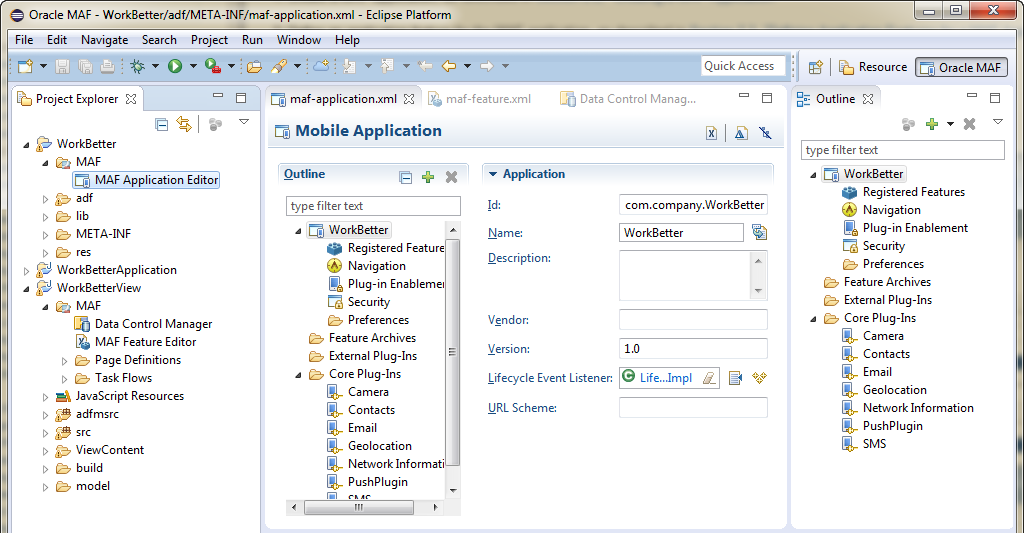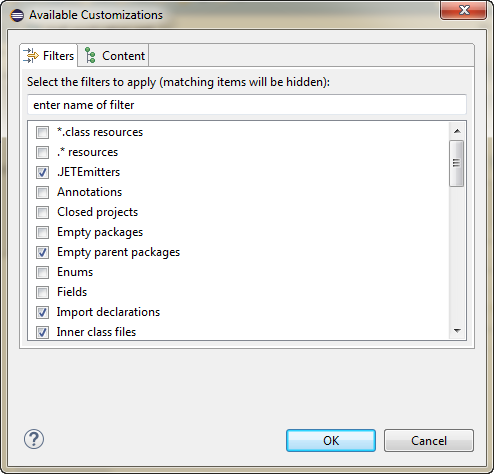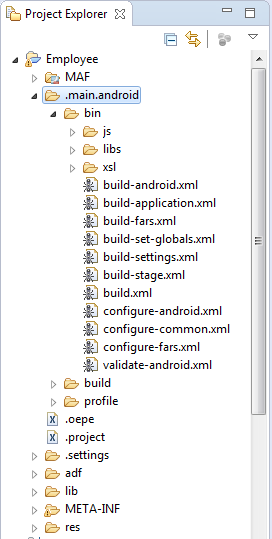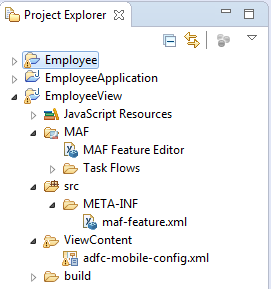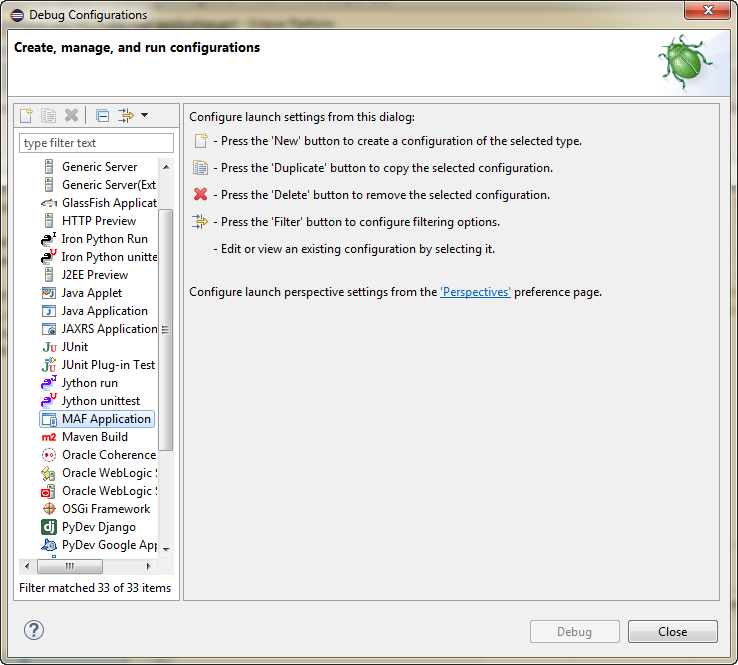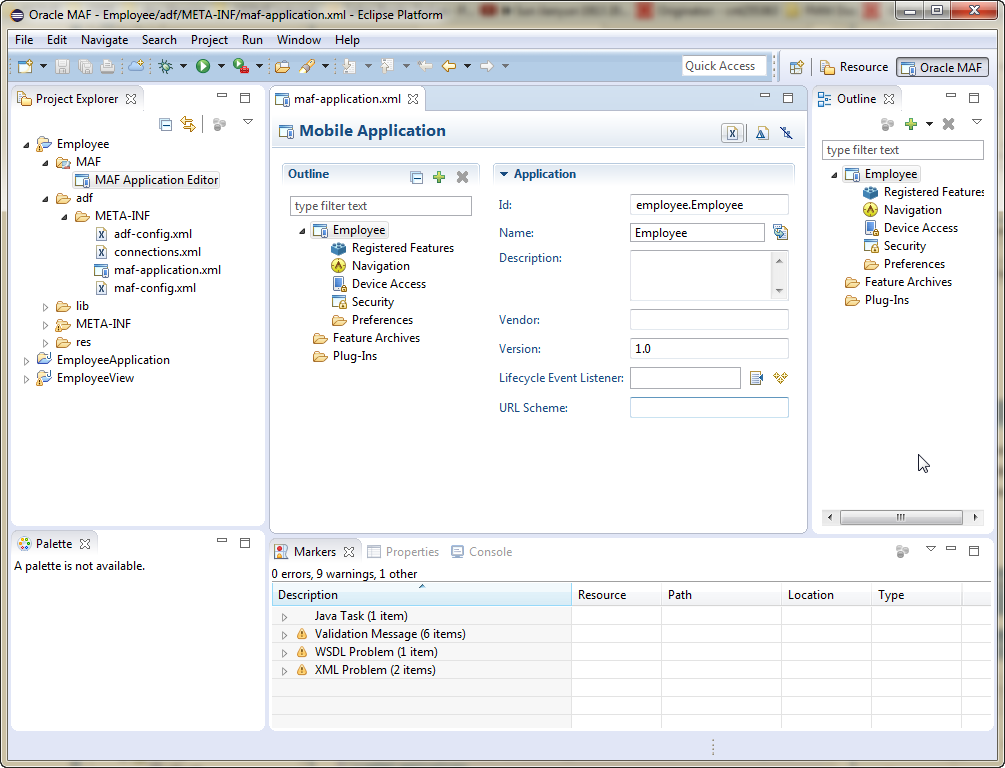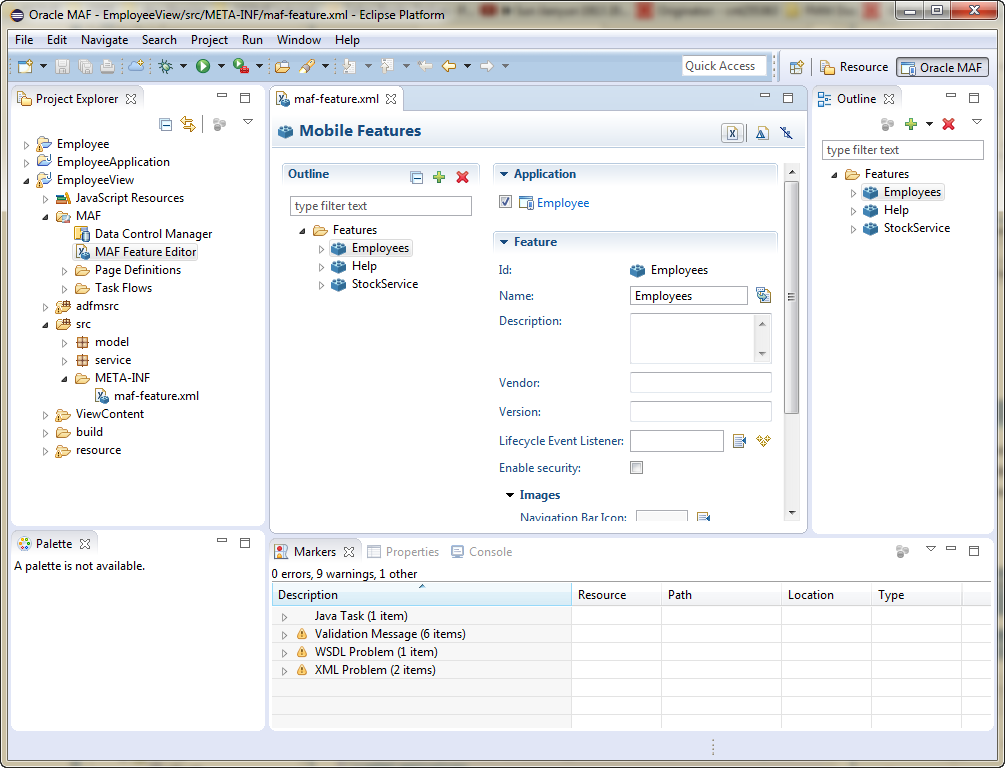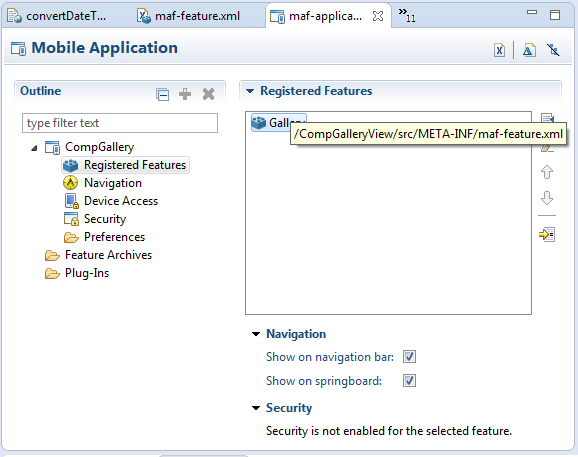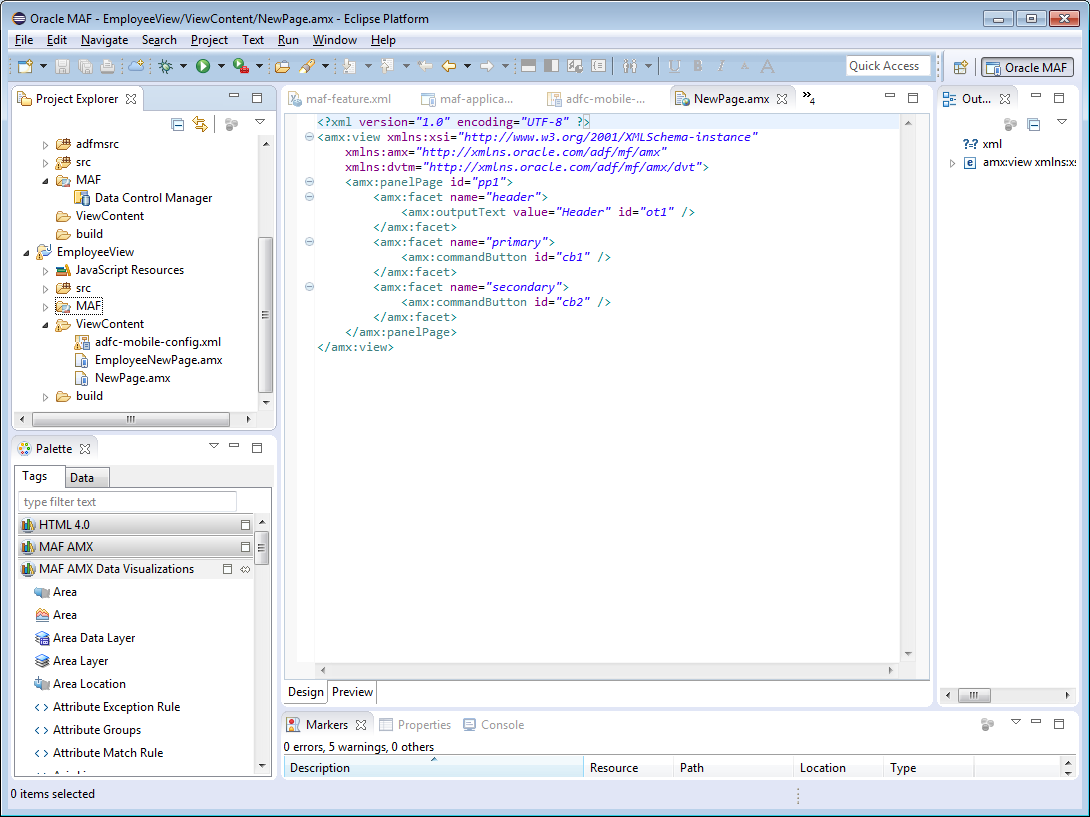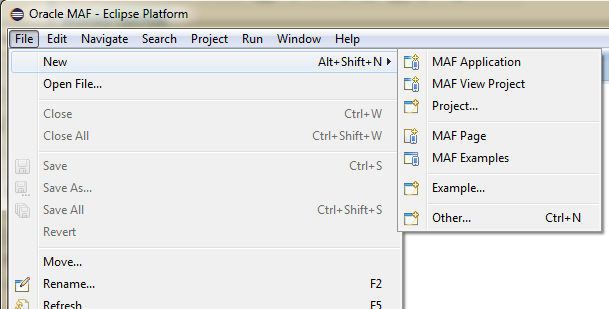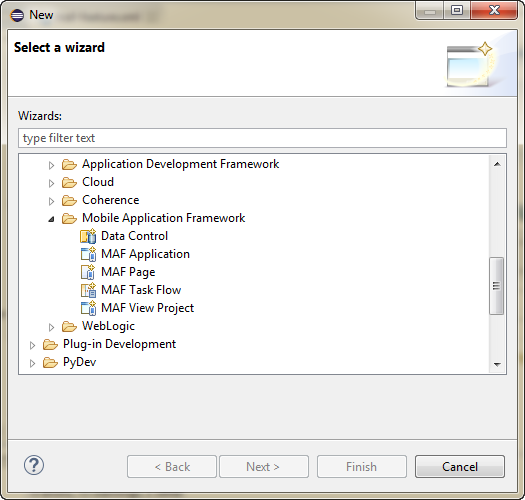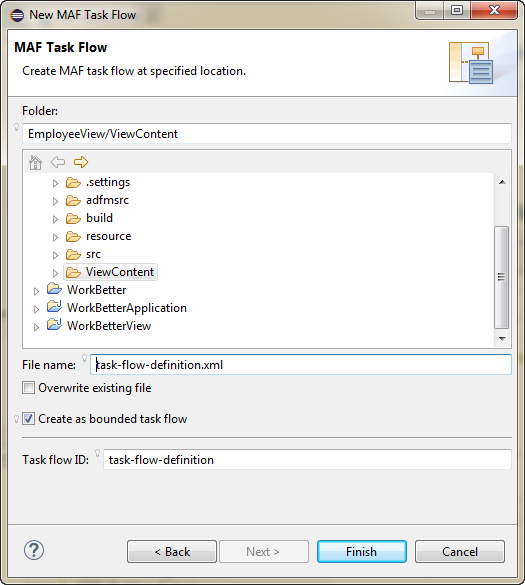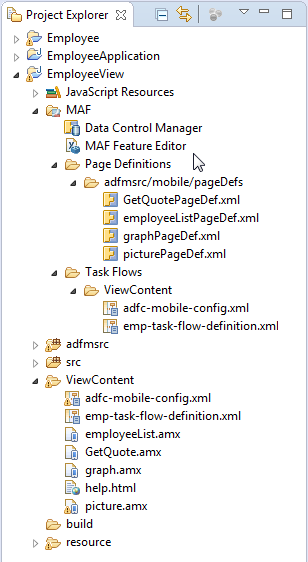2 Getting Started with MAF Application Development
This chapter describes how to create a MAF application in OEPE and introduces the files and other artifacts that OEPE generates when you create the application.
This chapter includes the following sections:
-
Section 2.1, "Introduction to Declarative Development for MAF Applications""
-
Section 2.4, "Containerizing a MAF Application for Enterprise Distribution"
2.1 Introduction to Declarative Development for MAF Applications
The Oracle Mobile Application Framework (MAF) extension in OEPE provides a number of editors and wizards to facilitate the development, testing, and deployment of MAF applications. Using these wizards, you can create a MAF application, define one or more application features, add content to an application feature, and deploy the MAF application to a test environment or device in a relatively short amount of time.
Figure 2-1 shows the WorkBetter sample application in OEPE's MAF Application Editor where a number of the items that you use to develop MAF applications are identified:
-
The MAF Application Editor (invoked from the assembly project), used to specify the MAF application's name, the default navigation menus (navigation bar or springboard) that the application renders, security, and device access options for the application.
-
The MAF Features Editor (invoked from the view project), where you define the application features that your MAF application contains.
The WorkBetter sample application is one of a number of sample applications that MAF provides to demonstrate how to create mobile applications using MAF. For more information, see Appendix G, "MAF Sample Applications."
EPE proposes default options in the wizards so that you can create a MAF application with one application feature displaying one MAF AMX page as follows:
-
Create a MAF application, as described in Section 2.2, "Creating a MAF Application."
-
Define an application feature for the MAF application, as described in <<need section and link, Defining Application Features for a MAF Application>>
-
Add content to the application feature, as described in <<need section and link, Adding Content to an Application Feature>>
2.2 Creating a MAF Application
You create a MAF application using the creation wizards in OEPE.
2.2.1 How to Create a MAF Application
You create a MAF application in OEPE using the application creation wizard.
-
In the main menu, choose File > New, and then select MAF Application.
-
In the MAF Application wizard, enter application details like name and deployment targets.
-
Click Finish.
2.2.2 What Happens When You Create an MAF Application
OEPE creates a MAF application with three projects:
-
The top-level or assembly project. This holds all of the artifacts required for packaging and deployment of the application. In addition, the assembly project tracks the version of the MAF run time that the project uses, if you are migrating an application from an earlier version of MAF.
-
The application project. This contains a Data Control Manager which abstracts the device features and the application features.
-
The view controller-type project. This contains the source folder (
src) and theViewContentfolder.
By default, OEPE opens the overview editor for the maf-features.xml file in the ViewController project of the newly-created MAF application, as shown in Figure 2-2. Use this overview editor to add one or more application features to your MAF application. A MAF application must have at least one application feature. For more about adding application features to a MAF application, see
OEPE adds application-level and project-level artifacts, which you access from the Project Explorer shown in Figure 2–6. These artifacts include two MAF editors:
-
MAF Application Editor which edits
maf-application.xml. It is used for configuring the MAF application itself, such as its name, the application lifecycle listener (LifeCycleListenerImpl.java), the login server connections for the embedded application features. For more information, see described in Section 2.2.2.1, "About the Assembly-Level Resources." -
MAF Features Editor which edits
maf-feature.xml. It describes which application features comprise the MAF application. For more information, see Section 2.2.2.2, "About the View Project Resources."
OEPE creates:
-
The DeviceFeatures data control. The Apache Cordova Java API is abstracted through this data control, thus enabling the application features implemented as MAF AMX to access various services embedded on the device.
-
The ApplicationFeatures data control, which enables you to build a springboard page.
Note:
If you have the Error Log open when you create a MAF application you will see messages similar to:org.eclipse.core.runtime.CoreException: Illegal install location D:\p4\depots\OEPE\tools-eclipse\annex\maf-2.1\install for vmInstall oracle.eclipse.tools.maf.JVMCDCv201 contributed by oracle.eclipse.tools.maf.dt.v201: Associated MAF runtime is not installed.
There will be one entry for each release of MAF with OEPE. You can safely ignore them.
By dragging and dropping the operations provided by the DeviceFeatures data control into a MAF AMX page (which is described in Section 14.10, "Using the DeviceFeatures Data Control," you add functions to manage the user contacts stored on the device, create and send both e-mail and SMS text messages, ascertain the location of the device, use the device's camera, and retrieve images stored in the device's file system.
By default, some files are filtered from view in the Project Explorer. In order to see the generated artifacts required for packaging and deployment of the application, click the down arrow in the explorer toolbar and choose Customize View.
In the Available Customizations dialog, shown in Figure 2–7, deselect .* resources and click OK.
Now expand the assembly project node and .main.android or .main.ios node to view the package and deploy artifacts, as shown in Figure 2–8.
To filter these files from the view in the Project Explorer, reopen the customization dialog and select .* resources and click OK.
2.2.2.1 About the Assembly-Level Resources
OEPE generates the files for the MAF application in the assembly project. These files contain configuration files for describing the metadata of the MAF application. You access these files from the res node under the assembly project in the Project Explorer, shown in Figure 2–9.
The assembly project (which is generated with the default name, application), which contains the application-wide resources, provides the presentation layer of the MAF application in that it includes metadata files for configuring how the application will display on a mobile device. This project dictates the security for the MAF application and can include the application's login page, an application-wide resource. The application controller project is essentially a consumer of the view controller project, which defines the application features and their content. For more information, see Section 2.2.2.2, "About the View Project Resources."
Tip:
Place code that supports application-wide functionality, such as an application-level lifecycle listener, in the application controller project.Within the application project itself (which is generated with the default name, applicationApplication), shown in Figure 2–10, OEPE creates the following artifacts, listed in Table 2–10.
2.2.2.2 About the View Project Resources
The view project (which is generated with the default name, applicationView), as illustrated in Figure 2–11) houses the resources for the application features. Unlike the application project described in Section 2.2.2.1, "About the Assembly-Level Resources," the view project's metadata files describe the resources at the application feature-level, in particular the various application features that can be aggregated into a MAF application so that they can display on a mobile device within the springboard of the MAF application itself or its navigation bar at runtime. Further, the application feature metadata files describe whether the application feature is comprised of HTML or MAF AMX pages. In addition, the view controller project can include these application pages as well as application feature-level resources, such as icon images to represent the application feature on the springboard and navigation bar defined for the MAF application.
Tip:
Store code specific to an application feature within the view controller project. Use the application controller project as the location for code shared across application features, particularly those defined in separate view controller projects.The view controller project can be decoupled from the application controller project and deployed as an archive file for reuse in other mobile applications as described in Section 9.1, "Working with Feature Archive Files." In rare cases, an application controller project can consume more than one view controller project.
Note:
Adding a MAF view controller project as a dependency of another MAF view controller project, or as a dependency of a MAF application controller project, prevents the deployment of a MAF application.These resources include the configuration file for application features called maf-feature.xml, which you edit using the MAF Feature Editor.
2.2.2.2.1 How to Create Multiple View Projects
Each OEPE assembly project can have more than one view project, in addition to the view project included when you first create your assembly project. The features included in this view project will be available from the application created when you build and deploy the assembly project.
To create a new view project in an existing assembly project:
-
Click File > New > MAF View Project. This opens the MAF View Project Wizard.
-
From the wizard, click Browse to select the assembly project to which you wish to add a new view project.
-
OEPE automatically gives the new view project a unique name that matches the assembly project. For example, if you are creating a new view project within the CompGallery sample application, the wizard names the view project
CompGalleryView1(to distinguish it from the defaultCompGalleryViewproject initially created.If desired, you can edit the name of the new view project at this time.
-
Click Finish to create the new view project.
The wizard adds view project files to the assembly project you selected in step 2.
2.2.2.3 About Deployment Configurations
OEPE uses deployment configurations to determine how applications are run or debugged. The configuration defines the way the packages into the archive that will be deployed to the target environment (such as a mobile device, an emulator, or an application marketplace, such as the iOs App Store). The deployment configuration:
-
Specifies the format and contents of the archive file that will be created
-
Lists the source files, deployment descriptors, and other auxiliary files that will be packaged
-
Describes the type and name of the archive file to be created
-
Highlights dependency information, platform-specific instructions, and other information
When you create an application, OEPE creates deployment configurations that are seeded with default settings and image files. By default, one deployment target is created for each SDK you have. Provided that you have configured the environment correctly, you can use these configurations to test an MAF application immediately after creating it by choosing Run and then Debug Configurations, as shown in Figure 2–12.
Note:
During development, use Debug Configuration. For production deployment, use the Run Configuration.Choosing Debug Configurations rather than Run Configurations allows OEPE to use, if necessary, debug settings such as the default debug keystore.
In the Create Configuration dialog, shown in Figure 2–13, create a new configuration by clicking ![]() .
.
Using the Configurations page, shown in Figure 2–14, you then select the appropriate deployment target.
Note:
iOS and Android application deployments to simulators and devices have distinct environment set up and configuration requirements. For more information, refer to the "Before You Begin" sections throughout Section 29.3, "Deploying an Android Application," and Section 29.4, "Deploying an iOS Application."You can create a MAF Application configuration for each supported platform and device or emulator.
You can edit these configurations by selecting the configuration from the list under MAF Applications. For information on the values configured for MAF application configurations, see Section 29.3.1, "How to Create an Android Deployment Configuration" and Section 29.4.1, "How to Create an iOS Deployment Configuration."
In addition to the platform-specific deployment configurations, MAF also creates a deployment configuration that enables you to package the MAF application as a Mobile Application Archive (.maa) file. Using this file, you can create a new MAF application using a pre-existing application that has been packaged as an .maa file. For more information, see Section 29.6, "Creating a Mobile Application Archive File" and Section 29.7, "Creating Unsigned Deployment Packages."
2.2.3 What You May Need to Know About Editing MAF Applications and Application Features
Creating an application results in the generation of the maf-application.xml file, which enables you to configure the mobile application and also the maf-feature.xml file, which you use to add, remove, or edit the application features embedded within the mobile application. OEPE provides you with the MAF Application Editor for maf-application.xml and with the Mobile Features Editor for maf-feature.xml. These let you declaratively change these files. Figure 2–15 shows an example of the MAF Application Editor open in OEPE.
As shown in Figure 2–15, the MAF Application Editor is located in the Project Explorer under the application and MAF node. The maf-application.xml file is located under the application, adf, and META-INF nodes. You open this editor by double-clicking MAF Application Editor.
As illustrated in Figure 2–16, the MAF Feature Editor is located in Explorer under the view project and MAF node. The maf-feature.xml file is located under the view project, src, and META-INF nodes. You open this editor by double-clicking MAF Feature Editor, or by double-clicking maf-feature.xml. You use this file to compose the content for the MAF application.
Like the MAF Application Editor for editing the maf-application.xml file, OEPE presents the MAF components used for building the elements of the maf-features.xml configuration file in the MAF Feature Editor.
2.2.4 About the MAF Application Editor and MAF Feature Editor
OEPE's MAF Feature Editor and MAF Application Editor are the primary tools you use to interact with a MAF application while you are creating it. These two editors interact with each other, and with the files that comprise the application you are developing, in a way that can affect your choices while editing.
When you use the MAF Application Editor to make changes to maf-application.xml, OEPE opens not only that file, but other files related to that application. These might include any registered feature files (edited with MAF Feature Editor) and plugins. To view some of these files in the MAF Application Editor, expand the Outline and select Registered Features. In addition, files in the Features folder (if any) may also be affected. Figure 2–17 shows the MAF Application Editor open to the Registered Feature listing, which the tooltip shows is connected to the file maf-feature.xml.
If you double-click on maf-feature.xml in the Registered Features pane of the MAF Application Editor, OEPE opens the file in the MAF Feature Editor, as expected. The interaction between these two files (and others as applicable) while you are editing, however, deserves attention.
When you go to the MAF Application Editor and save your application file, OEPE checks to determine whether the related feature file has been changed externally in the file system. If it has, OEPE displays a confirmation dialog informing you that the related file has been changed relative to the contents of the editor. You have the chance at this point to choose one of the following options:
-
Reload the editor. This copies the changes from your file system into the MAF Application Editor, overwriting any changes you may have made to the file.
-
Not reload the editor. This saves the
maf-feature.xmlfile and overwrites the contents of your file system.
OEPE performs a similar check if you select File > Save All. In addition, the File > Close All function checks to see whether you have files open in the MAF Application Editor and MAF Feature Editor, and checks for conflicts in those open files before closing. This helps prevent data loss.
2.3 Creating a MAF AMX Page
As described in Chapter 12, "Creating MAF AMX Pages," the MAF AMX components enable you to build pages that run identically to those authored in a platform-specific language. MAF AMX pages enable you to declaratively create the user interface using a rich set of components. Figure 2–18 illustrates the declarative development of an MAF AMX page, which involves selecting options in the Palette and adding them to the MAF AMX page.
These pages may be created by the application assembler, who creates the MAF application and embeds application features within it, or they can be constructed by another developer and then incorporated into the MAF application either as an application feature or as a resource to an MAF application.
The project in which you create the MAF AMX page determines if the page is used to deliver the user interface content for a single application feature, or be used as a resource to the entire MAF application. For example, a page created within the application controller project, as shown in Figure 2–22, would be used as an application-wide resource.
Tip:
To make pages easier to maintain, you can break it down in to reusable segments known as page fragments. An MAF AMX page may be comprised one or more page fragments.MAF enables you to arrange MAF AMX view pages and other activities into an appropriate sequence through the MAF task flow. As described in Chapter 12.2, "Creating Task Flows," an MAF task flow is visual representation of the flow of the application. It can be comprised of MAF AMX-authored user interface pages (illustrated by such view activities, such as the WorkBetter sample application's default List page and the Detail page in Figure 2–19) and nonvisual activities that can call methods on managed beans. The non-visual elements of a task flow can be used to evaluate an EL expression or call another task flow. As illustrated by Figure 2–19, MAF enables you to declaratively create the task flow by dragging task flow components onto a diagrammer. MAF provides two types of task flows: a bounded task flow, which has a single point of entry, such as the List page in the WorkBetter sample application, and an unbounded task flow, which may have multiple points of entry into the application flow. The WorkBetter sample application sample application is This sample application is available from File > New > MAF Examples.
MAF provides a number of dialogs and wizards to add MAF pages, reusable portions of MAF AMX pages called MAF page fragments, and application features. Figure 2–20 shows the menu options available from the File menu.
Additional options are available from File > New > Other (see Figure 2–20). In the New dialog, expand Oracle then expand Mobile Application Framework
2.3.1 How to Create an MAF AMX Page
You can use the MAF Page dialog to create AMX pages used for the user interface for an application feature, or as an application-level resource (such as a login page) that can be shared by the application features that comprise the MAF application. For more information on application feature content, see Section 6.2, "How to Define the Application Feature Content as Remote URL or Local HTML."
To create an MAF AMX page as Content for an Application Feature:
-
Choose File > New and then MAF Page.
-
Complete the New MAF Page dialog, shown in Figure 2–22, by choosing the parent folder, for example
ViewContentand entering a name in the File Name field. -
Select (or deselect) the Page Facets that are used to create a primary and secondary header and footer. Click OK.
For more information, see Section 13.2.2, "How to Use a Panel Page Component."
-
Click Finish. For more information using the AMX components, see Section 12.3.1.2, "Creating MAF AMX Pages." See also Section 6.2, "How to Define the Application Feature Content as Remote URL or Local HTML."
To create an MAF AMX page as a Resource to an MAF application:
-
Choose File > New and then MAF Page.
-
Complete the Create MAF AMX Page dialog, shown in Figure 2–22, by entering a name in the File Name field. In the Directory field, enter the file location, which must be within the
public_htmlfolder of the application controller project. Click OK. -
Build the MAF AMX page. For more information, see Section 12.3.1.2, "Creating MAF AMX Pages."
2.3.2 How to Create MAF Task Flows
You can deliver the content for an application feature as an MAF task flow.
To create an MAF Task Flow as content for an application feature:
-
Choose File > New > Other.
-
In the New dialog, expand Oracle then expand Mobile Application Framework. Select MAF Task Flow and click Next.
-
Complete the New MAF Task Flow dialog, shown in Figure 2–23, by entering a name in File Name. Click OK.
-
Click Finish to build the task flow. See also Section 12.2, "Creating Task Flows."
2.3.3 What Happens When You Create MAF AMX Pages and Task Flows
OEPE places the MAF AMX pages and task flows in the ViewContent node of the view project, as shown by employeeList.amx and emp-task-flow-definition.xml in Figure 2–24. These artifacts are referenced in the maf-feature.xml file.
The task flows are also listed under the view project MAF node.
Other resources, such as customized application splash screen (or launch) images and navigation bar images, are also housed in the ViewContent node.
To manage the unbound task flows, OEPE generates the adfc-mobile-config.xml file. Using this file, you can declaratively create or update a task flow by adding the various task flow components, such as a view (a user interface page), the control rules that define the transitions between various activities, and the managed beans to manage the rendering logic of the task flow.
OEPE places the MAF AMX page and task flow as application resources to the mobile application in the ViewContent node of the application controller project. As illustrated in Figure 2–24, the file for the MAF AMX page is called application_resource.amx and the task flow file is called ApplicationController-task-flow.xml (the default name).
2.4 Containerizing a MAF Application for Enterprise Distribution
At the time of deployment, you can choose to wrap the MAF application with the OMSS (Oracle Mobile Security Suite) to take advantage of its enterprise mobile application management capabilities. OMSS allows secure access to corporate apps and data from mobile devices while preserving a rich user experience. Its Mobile Security Container creates the enterprise Workspace on any iOS or Android device, corporate-owned or personal. Employees get seamless access to corporate data and apps with enterprise-grade security and single sign-on authentication.
With the Mobile Security App Containerization Tool, you can add a standardized security layer to native mobile apps. The containerization process is simple and injects the following security services into your app.
-
Secure data transport: An encrypted AppTunnel through Mobile Security Access Server to application back-end resources behind an enterprise firewall.
-
Authentication: Managed by the Secure Workspace app and provides single sign-on across apps in the secure workspace.
-
Secure data storage: Encrypted storage of app data, including files, database, app cache and user preferences.
-
Data leakage controls: The ability to restrict file sharing and copy paste to only other trusted apps. This enables you to control the sharing of data, including e-mail, messaging, printing and saving.
-
Dynamic policy engine: More than 50 detailed app controls, including authentication frequency, geo and time fencing as well as remote lock and wipe.
The OMSS single sign-on authentication and user identity propagation to MAF app services is supported only for applications configured to use the Web SSO authentication server type for login connections. Applications using HTTP Basic, OAuth, or Mobile-Social authentication will be required to log in to the MAF app after the Container authentication is successful. For details about these authentication types and the role they play in OMSS, see Section 30.5.12, "What You May Need to Know About Login Connections and Containerized MAF Applications."
The containerization process is simple and does not change the way you develop the MAF application. In fact, you should not change application code specifically with containerization in mind. You develop the MAF application the same way whether or not you intend to deploy with OMSS containerization enabled.
When you deploy the application with OMSS containerization enabled, OEPE runs the Mobile Security App Containerization Tool provided by OMSS to containerize the MAF application.
After deployment, the MAF app developer works with the OMSS system administrator to get the app added to OMSS Mobile App Catalog and to configure appropriate policies. For details, see the "Managing Mobile Apps" chapter in Administering Oracle Mobile Security Suite.
When the user launches the containerized MAF application, the Secure Workspace app redirects to the Mobile Security Container, which performs SSO authentication before handing the session back to the MAF application. The containerized MAF application does not require VPN to connect to internal websites or services. Instead a secure AppTunnel is established between the application and Mobile Security Access Server (MSAS), which provides secure transport for accessing internal sites and services that have been registered for access by mobile device users.
For more information about how OMSS containerization affects MAF applications, see these sections:
-
For the OEPE procedure to containerize the MAF application for OMSS, see Section 28.8, "Deploying with Oracle Mobile Security Suite."
-
For details about accessing secure web services behind the corporate firewall by the containerized MAF application, see Section 15.6.3, "What You May Need to Know About Accessing Web Services and Containerized MAF Applications."
-
For details about the authentication process of containerized MAF applications, see Section 30.4, "Overview of the Authentication Process for Containerized MAF Applications."
In the OMSS documentation library, refer to the following list of resources for details about OMSS administration tasks related to mobile devices and workspace containers.
-
For background information about OMSS, see the "Understanding Oracle Mobile Security Suite" chapter in Administering Oracle Mobile Security Suite.
-
For details about how system administrators use the OMSS Mobile Security Manager console to enroll the MAF application user's mobile device and workspace, see the "Enrolling Devices and Workspaces" chapter in Administering Oracle Mobile Security Suite.
-
For details about how system administrators use the OMSS Mobile App Catalog to manage the MAF application provisioned to devices and workspaces, see the "Managing Mobile Apps" chapter in Administering Oracle Mobile Security Suite.
-
For details about how system administrators use the OMSS Mobile Security Manager console to manage access to a corporate file shared by MAF application capabilities, see the "Managing Mobile Security Policies" chapter in Administering Oracle Mobile Security Suite.
In the OMSS documentation library, refer to the following list of resources for details about MSAS administration tasks related to securing resources and authentication.
-
For background information about MSAS, see the "Getting Started with Mobile Security Access Server" chapter in Administering Oracle Mobile Security Access Server.
-
For details about how system administrators create a proxy application to define forward proxy URLs for protected resources accessed by MAF applications, see the "Managing Mobile Security Access Server Applications" chapter in Administering Oracle Mobile Security Access Server.
-
For details about how system administrators attach predefined security policies to forward proxy URLs and secure access by the MAF application to protected web services, see the "Securing Mobile Security Access Server Resources" chapter in Administering Oracle Mobile Security Access Server.
-
For details about how system administrators configure a MSAS authentication endpoint to handle authentication on the MAF application user's mobile device by the Secure Workspace app, see the "Configuring a Mobile Security Access Server Instance" chapter in Administering Oracle Mobile Security Access Server.
